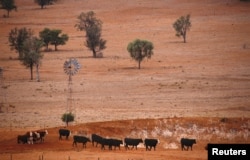ຈະມີການບັງຄັບການຈຳກັດການໃຊ້ນໍ້າຢູ່ໃນຊິດນີ ນະຄອນທີ່ໃຫຍ່ທີ່ສຸດຂອງອອສ
ເຕຣເລຍເປັນເທື່ອທຳອິດໃນຮອບເກືອນຶ່ງທົດສະວັດ ຍ້ອນລະດັບດັບນໍ້າຢູ່ໃນອ່າງ
ຫລຸດລົງ ແລະໄພແຫ້ງແລ້ງທີ່ມີມາເປັນເວລາຍາວນານ. ຊາວເມືອງຜູ້ທີ່ລະເມີດກົດ
ເກນດັ່ງກ່່າວອາດຖືກປັບໄໝເປັນເງິນຫລາຍເຖິງ 150 ໂດລາສະຫະລັດ. ຟຽລ ເມີເຊີ້ ສົ່ລາຍງານເລື້ອງນີ້ມາຈາກຊິດນີ ດັ່ງສາລີຈະນຳລາຍລະອຽດມາສະເໜີທ່ານ ໃນອັນ
ດັບຕໍ່ໄປ.
ນໍ້າຝົນທີ່ຕົກລົງມາໃສ່ອ່າງບາງບ່ອນຂອງນະຄອນຊິດນີ ແມ່ນຢູ່ໃນຂັ້ນຕໍ່າສຸດ ນັບຕັ້ງ
ແຕ່ສົງຄາມໂລກຄັ້ງທີສອງເປັນຕົ້ນມາ. ນັບຕັ້ງແຕ່ວັນເສົານີ້ເປັນຕົ້ນໄປ ພວກຄອບຄົວ
ຕ່າງໆຈະຕ້ອງໄດ້ປະເຊີນກັບການຈຳກັດຮັດແຄບ ບໍ່ໃຫ້ໃຊ້ນໍ້າຢູ່ນອກເຮືອນ. ການໃຊ້
ນໍ້າຫົດສວນຈະຖືກຫ້າມ ທັງຈະມີມາດຕະການທີ່ເຄັ່ງຄັດກວ່ານັ້ນຕິດຕາມມາ. ລັດຖະ
ບານຂອງລັດ ນິວຊາວຕ໌ເວນສ໌ ກ່າວວ່າ
“ການເອົາບົດບາດແຕ່ຫົວທີແລະເດັດດ່ຽວ” ຈະຊ່ອຍປະຢັດສະບຽງນໍ້າໃນຂະນະທີ່ໄພ
ແຫ້ງແລ້ງທະວີຄວາມຮ້າຍແຮງຂຶ້ນຢູ່ນີ້.”
ກົມອຸຕຸນຍົມວິທະຍາຂອງອອສເຕຣເລຍທຳນາຍວ່າລະດັບນໍ້າຝົນຈະຕົກລົງຕໍ່າກວ່າປົກ
ກະຕິແລະອຸນະພູມຂອງອາກາດຈະສູງຂຶ້ນໃນສາມເດືອນຂ້າງໜ້ານີ້ ໃນທົ່ວເກືອບວ່າທັງ
ທະວີບ. ທ່ານນາງມີລິນດາ ປາເວ ຫົວໜ້າບໍລິຫາເລື້ອງນໍ້າຂອງລັດ ນິວຊາວຕ໌ເວນສ໌
ກ່າວວ່າ:
“ຍ້ອນລະດັບນໍ້າທີ່ມີຢູ່ໃນຕໍ່າສຸດໃນອ່າງເກັບນໍ້າຊອງນະຄອນຊິດນີນັບຕັ້ງແຕ່ປີ 1940 ເປັນຕົ້ນມາ ລັດຖະບານຈຶ່ງໄດ້ຕັດສນໃຈວ່າ ມັນຈະເປັນການດີທີ່ສຸດທີ່ຈະໃຫ້ມີຂໍ້ຈຳກັດ
ກ່ຽວກັບການໃຊ້ນໍ້າ. ນໍ້າຝົນອາດຈະຕົກລົງມາໃຫ້ພວກເຮົາ. ການທຳນາຍຂອງກົມອຸຕຸນິ
ຍົມບໍ່ໄດ້ມອງເຫັນໃນແງ່ດີພໍທໍ່ໃດ ແຕ່ດັ່ງທີ່ພວກເຮົາຮູ້ ແລະວາງແຜນໄວ້ສຳລັບທ້າຍ
ສັບປະດາ ພວກເພິ່ນຈະເວົ້າບໍ່ຖືກສະເໝີໄປ ແລະຂ້າພະເຈົ້າຫວັງວ່າພວກເພິ່ນຈະເວົ້າ
ຜິດ. ພວກເຮົາຈະເອົາບາດກ້າວທີ່ເໝາະສົມ ໃຫ້ຢູ່ໃນລະດັບສົມມາສົມຄວນ.”
ລັດ ນິວຊາວຕ໌ເວນສ໌ ໄດ້ຕົກຢູ່ໃນສະພາບແຫ້ງແລ້ງມາຕັ້ງແຕ່ກາງປີ 2017.
ທ່ານນາງ ກາຕາຣີນ ພອຕ ປະຈຳຫ້ອງການວ່າດ້ວຍນໍ້າຂອງນະຄອນຊິດນີ ທີ່ລັດຖະ
ບານເປັນເຈົ້າຂອງ ເວົ້າວ່າ ພວກເຈົ້າໜ້າທີ່ຂອງຕົນຈະອອກລາດຕະເວນ ເພື່ອໃຫ້ແນ່
ໃຈວ່າຈະບໍ່ມີການລະເມີດຂໍ້ຫ້າມ ໂດຍເວົ້າວ່າ.
“ຊິດນີມີທີມງານຂອງພວກເຈົ້າໜ້າທີ່ກຳກັບນໍ້າຂອງປະຊາຄົມ ຊຶ່ງຈະພາກັນອອກໄປ ເພື່ອຕິດຕາມເບິ່ງ ແລະໃຫ້ແນ່ໃຈວ່າ ຂໍ້ຫ້າມເລື້ອງຈະຖືກປະຕິບັດ. ຄ່າປັບໄໝສ່ວນບຸກ
ຄົນຈະແມ່ນ 220 ໂດລາອອສເຕຣເລຍ ແລະສຳລັບທຸລະກິດຈະແມ່ນ 550 ໂດລາ.
ເຖິງຢ່າງໃດກໍດີ ພວກນັກວິຈານຈະພາກັນເວົ້າວ່າຊະຕາກຳຂອງຊິດນີເປັນພາກສ່ວນນຶ່ງ
ຂອງການວາງແຜນທີ່ບໍ່ດີ ແລະຄວາມລົ້ມແຫລວໃຊ້ນໍ້າໝູນວຽນທີ່ເອົາຈິງເອົາຈັງ.
ການຫລຸດຕໍ່າລົງຂອງລະດັບນໍ້າໃນອ່າງໄດ້ເລັ່ງລັດໃຫ້ພວກເຈົ້າໜ້າທີ່ໄດ້ຫັນໄປແປຮູບ
ນໍ້າເຄັມມູນຄ່າຫລາຍໆພັນລ້າໂດລາໃນເດືອນມັງກອນຜ່ານມາ. ຖ້າຈັດຕັ້ງປະຕິບັດ
ໂດຍເຕັມອັດຕາ ສະບຽງນໍ້າກໍຈະພໍໃຊ້ໃນຊິດນີ ນະຄອນທີ່ມີປະຊາກອນ 4 ລ້ານ 6 ແສນ
ຄົນ ສຳລັບ 15 % ຂອງປະລິມານນໍ່າທີ່ຕ້ອງການ.
Water restrictions are to be imposed in Sydney, Australia’s biggest city, for the first time in almost a decade because of falling reservoir levels and a long-standing drought. Residents who breach the regulations could be fined US$150.
The flow of rainwater into some of Sydney’s reservoirs is at its lowest since World War II. From Saturday, households will face restrictions that will target the use of water outdoors. Garden sprinklers will be banned, and tougher measures could follow. The New South Wales state government says that “early and decisive action” will help to conserve supplies as a record-breaking drought worsens.
Australia’s Bureau of Meteorology is predicting below-average rainfall and higher temperatures for the next three months across the much of the continent.
“With the lowest inflows into Sydney’s water storage since 1940, the government has come to a decision that it is best to go into water restrictions," said Melinda Pavey, the New South Wales state Minister for Water. "We may get rain. The Bureau of Meteorology’s predictions are not fabulous, but as we know as we plan weekends, they are not always right and I hope that they are wrong. We are taking the appropriate course of action to take it to level one.”
New South Wales has been in drought since the middle of 2017.
Catherine Port, from Sydney Water, a government-owned company, says its officers will patrol to ensure the water ban is not broken.
“Sydney Water have a team of community water officers that will be out in the community to monitor and ensure that water restrictions are complied with. Penalties that will apply is AUD$220 for individuals and $550 for businesses,” she said.
Critics, though, insist that Sydney’s plight is in part the result of poor planning and a failure to take water recycling seriously.
Falling reservoir levels prompted authorities to switch on a multi-million dollar desalinization plant in January. At full capacity, it could supply Sydney, a city of 4.6 million people, with 15 per cent of its water needs.
Smaller towns in New South Wales, Australia’s most populous state, are also facing water crises. In Tamworth, residents are on level four restrictions that ban all use of water outdoors, and swimming pools cannot be filled or topped up. Level five restrictions are considered to be an emergency measure.
Australia is the world’s driest inhabited continent.












